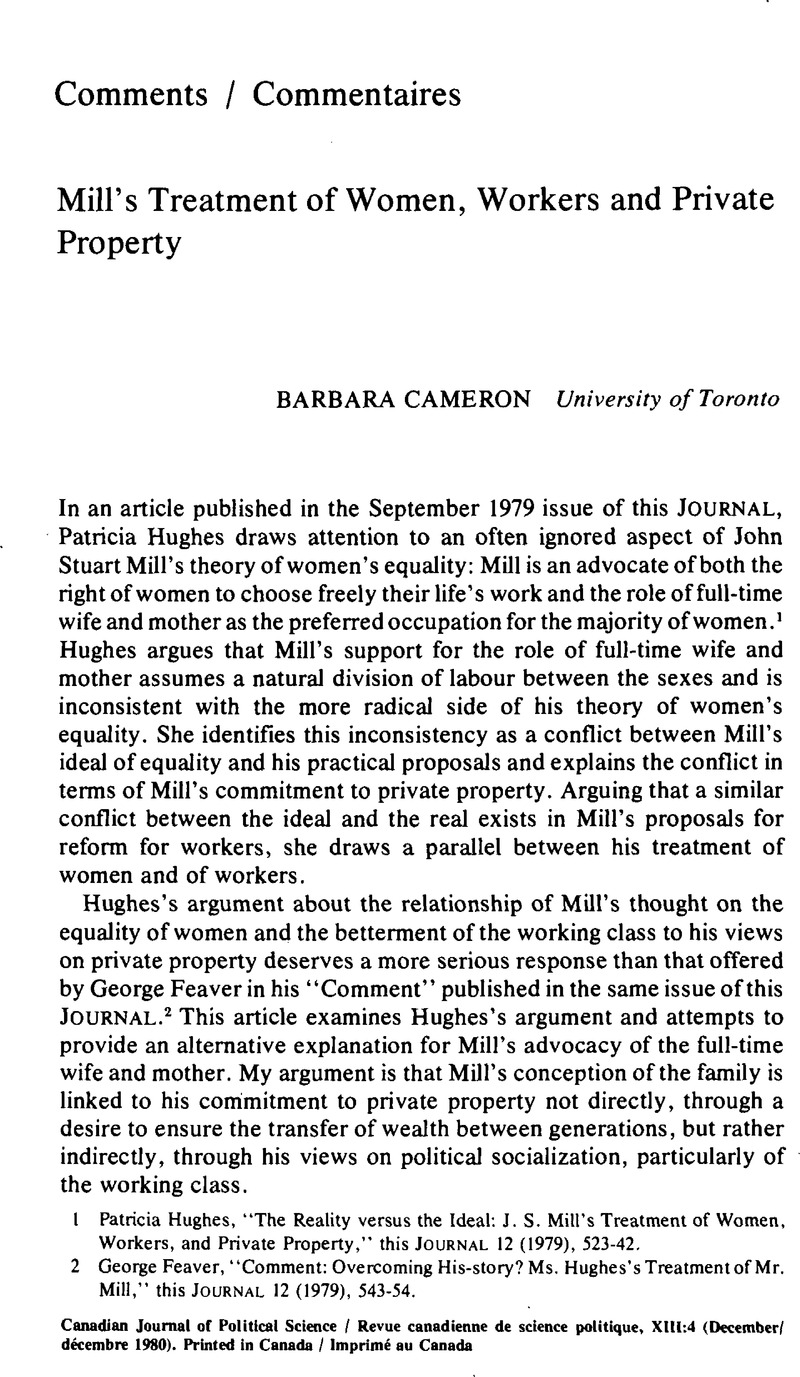Article contents
Mill's Treatment of Women, Workers and Private Property
Published online by Cambridge University Press: 10 November 2009
Abstract

- Type
- Comments/Commentaires
- Information
- Canadian Journal of Political Science/Revue canadienne de science politique , Volume 13 , Issue 4 , December 1980 , pp. 775 - 783
- Copyright
- Copyright © Canadian Political Science Association (l'Association canadienne de science politique) and/et la Société québécoise de science politique 1980
References
1 Hughes, Patricia, “The Reality versus the Ideal: J. S. Mill's Treatment of Women, Workers, and Private Property,” this JOURNAL 12 (1979), 523–42Google Scholar.
2 Feaver, George, “Comment: Overcoming His-story? Ms. Hughes's Treatment of Mr. Mill,” this JOURNAL 12 (1979), 543–54Google Scholar.
3 Mill, John Stuart, “The Subjection of Women,” in On Liberty, Representative Government, The Subjection of Women. Three Essays (London: Oxford University Press, 1964), 486 (hereinafter Three Essays)Google Scholar.
4 Mill, “The Subjection of Women,” in Three Essays, 483.
5 See Mill, , Principles of Political Economy, Vol. 2 (London: Longmans, Green, Reader and Dyer, 1871), 341, for his opinion of those reformers who wish to prohibit women from competing for certain industrial jobsGoogle Scholar.
6 Mill, “The Subjection of Women,” in Three Essays, 483.
7 Hughes, “The Reality versus the Ideal,” 539.
8 Mill, “The Subjection of Women,” in Three Essays, 482.
9 In his writings on political economy, Mill considers regarding the labour of the mother in bringing up a child to the age and strength to become a labourer as productive labour to be remunerated out of the final cost of a product. He rejects this because the labour and expense is incurred by individuals for reasons other than financial return. Mill, Principles, Vol. 1, 50.
10 Ibid., 277.
11 Ibid., 281–83.
12 Mill, “The Subjection of Women,” in Three Essays, 484.
13 Ibid., 448.
14 The legal position of married women, as described by nineteenth-century feminists, was that “the husband and wife are one, and that one is the husband.” For a discussion of patriarchal assumptions and the political rights of wage-earners see Macpherson, C. B., Democratic Theory: Essays in Retrieval (Oxford: Clarendon Press, 1977), 207–23Google Scholar.
15 Mill, “On Liberty,” in Three Essays, 79.
16 Mill, “The Subjection of Women,” in Three Essays, 544.
17 Mill, “Considerations on Representative Government,” in Three Essays, 276.
18 Mill, “The Subjection of Women,” in Three Essays, 479.
19 Mill provides no explanation for his assumption that the socialization of children is the responsibility of women. This omission lends support toHughes's contention that Mill shared with his contemporaries certain prejudices about the natural division of labour between the sexes. Despite his criticisms of many popular prejudices about women's nature, Mill displayed some ambivalence about whether or not the abilities of the sexes were identical. He was consistent in maintaining that any differences that might be found in a reformed society to exist were complementary and would not provide grounds for a legally enforced inequality of women.
20 Mill, “The Subjection of Women,” in Three Essays, 541.
21 Hughes, “The Reality versus the Ideal,” 541.
22 Mill, Principles, Vol. 2, 343–78.
23 For a discussion of the development of the ‘‘modern conception that in the rearing of children and in home-making, the married woman makes an adequate economic contribution,” see Pinchbeck, Ivy, Women Workers and the Industrial Revolution, 1750–1850 (New York: Augustus M. Kelley, 1979), 312–13Google Scholar.
24 For example, in discussing his preference for the full-time wife and mother in the working class family, Mill argues: “If, in addition to the physical suffering of bearing children, and the whole responsibility of their care and education in early years, the wife undertakes the careful and economic application of the husband's earnings to the general comfort of the family; she takes not only her fair share, but usually the larger share, of the bodily and mental exertion required by their joint existence” (Mill, “The Subjection of Women,” in Three Essays, 483).
25 The two nineteenth-century Marxist classics on the relationship between the status of women and the struggle of the working class against private property are August Bebel's, Woman Under Socialism (New York: Schocken Books, 1975)Google Scholar, first published in 1883, and Engels', FrederickThe Origin of the Family, Private Property and the State (New York: International Publishers, 1972), first published in 1884Google Scholar.
- 1
- Cited by




